Rev. William Horace Dimmock
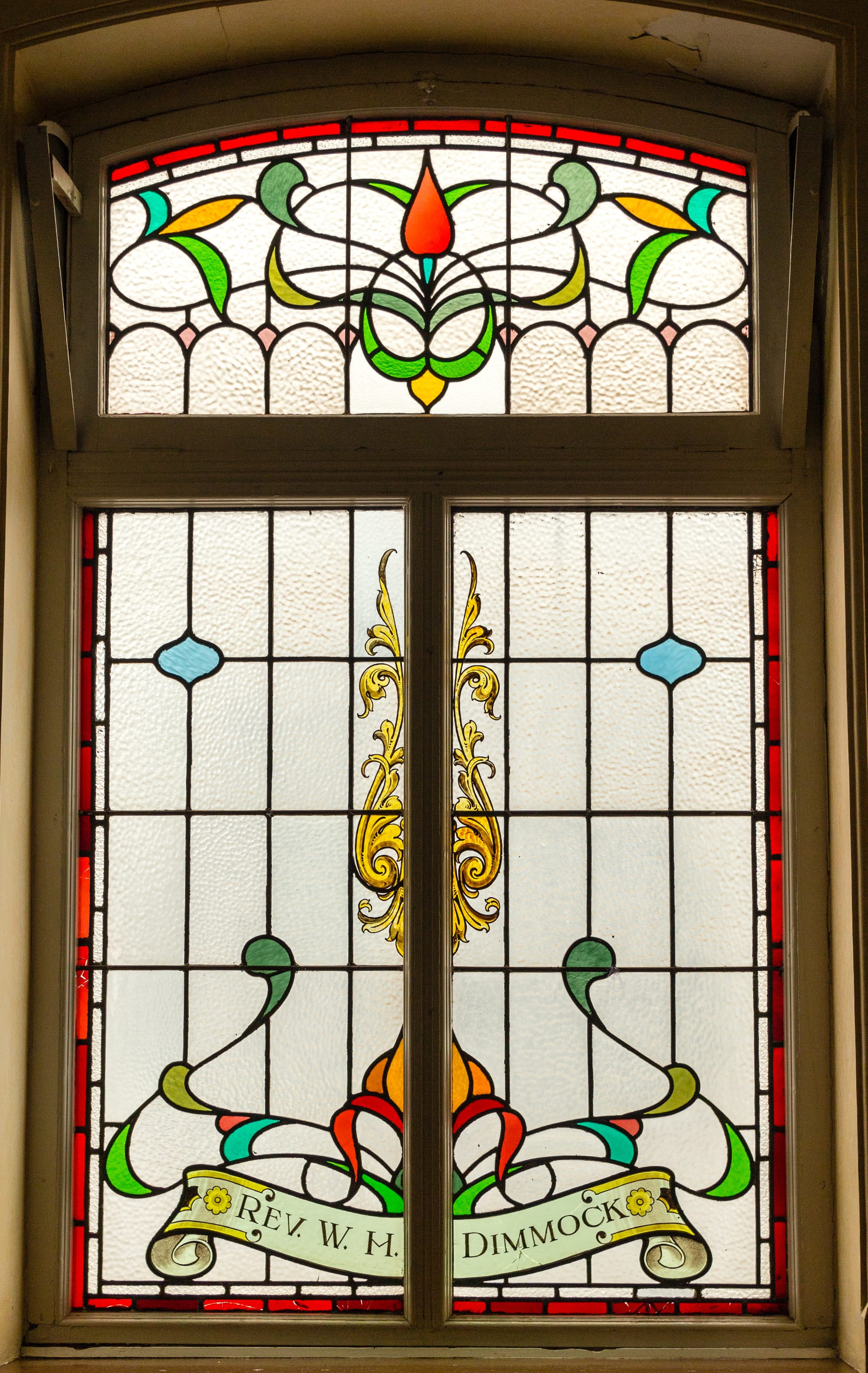
“First on the Ministerial Roll Of Honour”
William Horace Dimmock was born at Rowley Regis, Staffordshire, on February 4th 1890, the eldest son of Christian parents Samuel and Julia Dimmock and brother to Joseph, Clara, Dora, Mabel and Elsie.
William became a member at the Old Hill Wesleyan Methodist church in the Dudley circuit. The family later moved to Oakham View, 18 Arch Hill Street, Netherton and became members of the Netherton Wesleyan chapel. He became a local preacher at 17 and was accepted as a candidate for the Wesleyan ministry in 1909. He studied at Richmond College from 1911 and in 1913 was placed on the Presidents List of supply ministers.
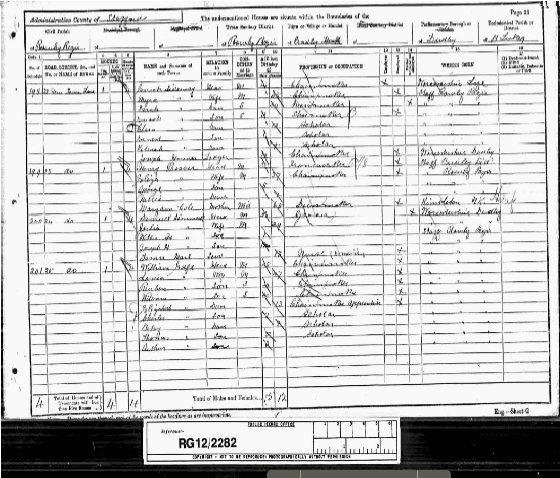
1891 census showing William Dimmock aged one
At the time of William’s birth Samuel was described as a grocer, but by 1901 was a mining engineer.
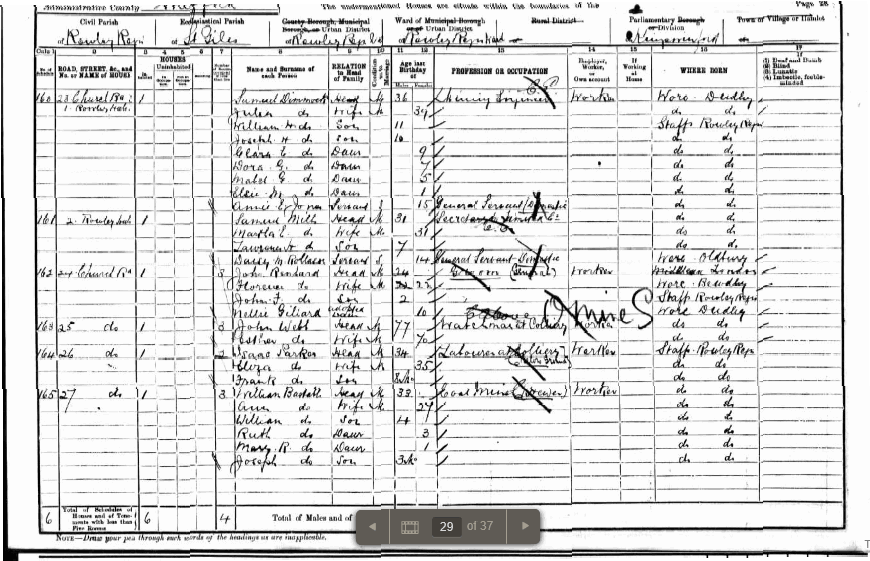
1911 Census return showing William Dimmock as a theological student at Richmond.
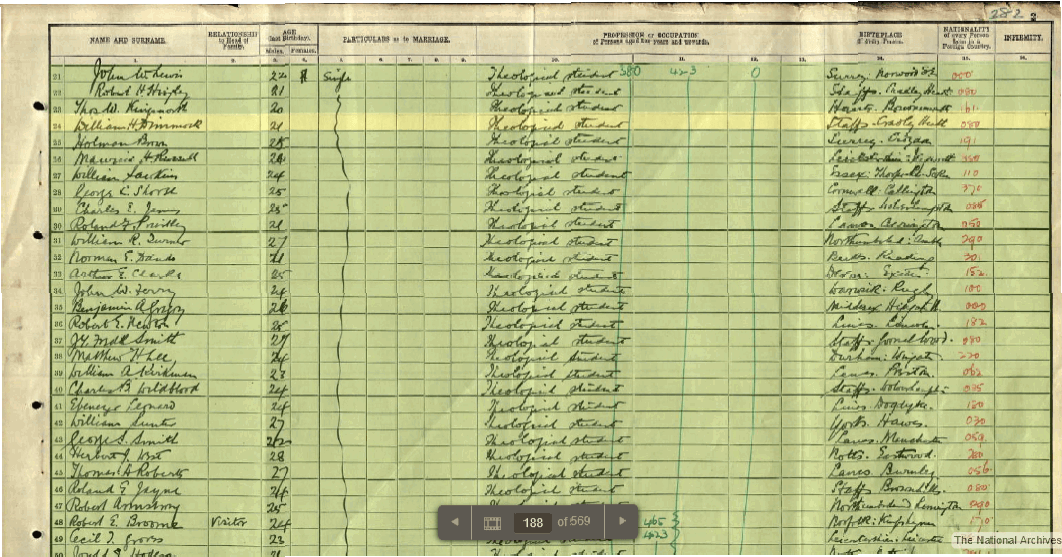
He was sent to Ashby in the Scunthorpe and Brigg circuit as a probationer minister. He was the first minister to be stationed in Ashby, the circuit having employed a number of lay agents in the growing work there. He was highly thought of while at Ashby, but probationers did not linger in those days and the Conference of 1914 stationed Roland Priestley at Ashby and William Dimmock was sent to Bradley church as third minister to the Bilston circuit in the Birmingham & Shrewsbury District.

A few days after his appointment, however, Britain was at war with Germany. After six months he came to the decision that he must take a different role in the struggle and in February 1915 he offered himself for active service. He enlisted as a private (Service number 13033) in the Legion of Frontiersmen (Royal Fusiliers) and was sent to British East Africa. In June 1915 his regiment sailed across Lake Victoria from Kisumu (now in Kenya) to be landed on the other side in order to take the town of Bukoba (then in German East Africa, now in Tanzania). Despite being landed in a swamp and held down by sniper fire the Frontiersmen took the town on June 23rd. William Dimmock died in the attack on June 23rd 1915 at the age of 25. He was originally buried in a cemetery at Mwanza, but in 1975 was re-buried in the Dar Es Salaam War Cemetery in Tanzania. His brother Joseph survived the war, having served in the Royal Engineers.
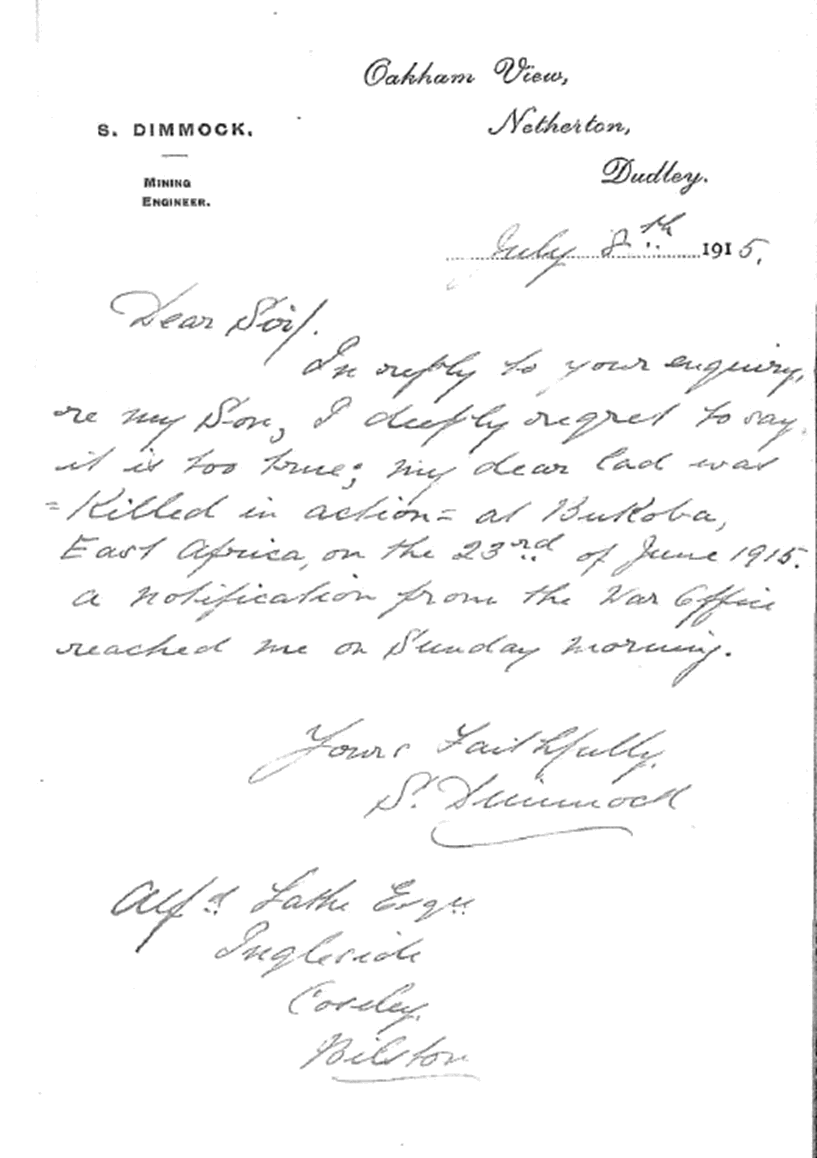
A letter written by Samuel Dimmock confirming the news of his son’s death.
Locally the Scunthorpe & Lincolnshire Star reported on July 17th “ASHBY: FALLEN.- Much regret will be felt here and in the district by the news that the Rev. W. H. Dimmock, who entered the ministry in 1913 and was last conference appointed to the Bilston Circuit, was killed in action at Bukoba, East Africa June 23rd . Mr Dimmock was stationed at Bradley and Hurst Hill. By the force of his preaching and his genial personality he endeared himself to the people and when he decided last March to give his services to his country, much regret was expressed. He joined the Legion of Frontiersmen as a private and in May set sail for Mombasa. He was very optimistic about returning, and letters had only just been received conveying his remembrances to old friends. Our sympathies are with the parents and family of our brother, who laid down his life for his country.
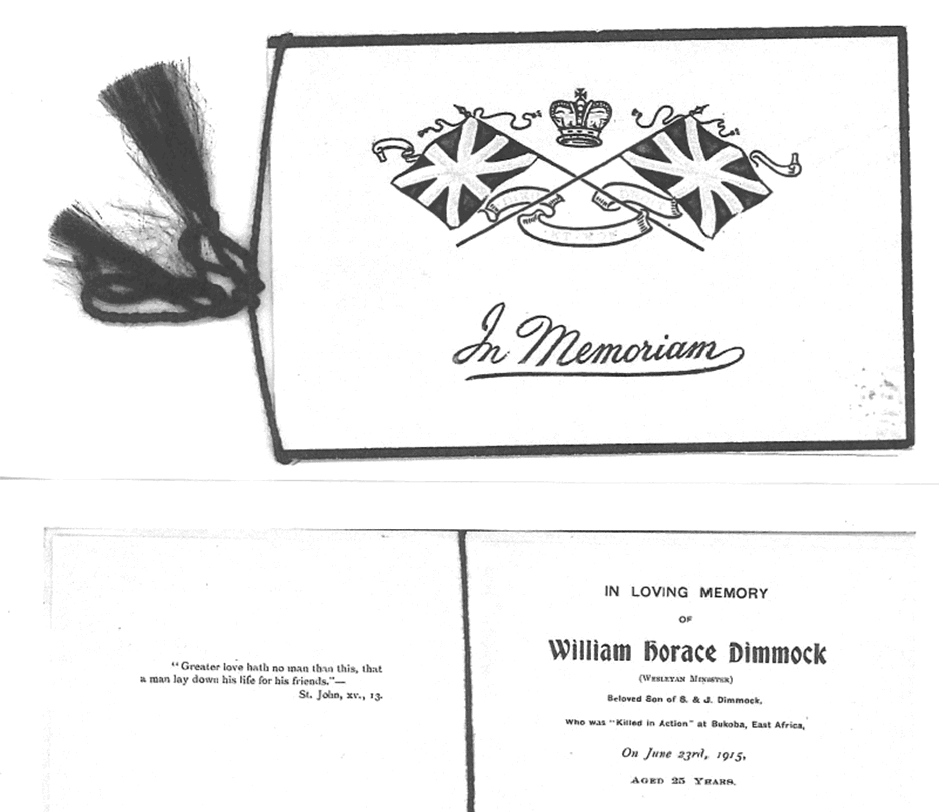
Memorial Card for William Dimmock
A week later the paper reported a memorial service held in the Scunthorpe Wesleyan chapel (later Trinity).
ASHBY
A FALLEN MINISTER – The esteem in which the late Rev. W. H. Dimmock, whose death we recorded, he having fallen in action as a private, was held, as amply demonstrated at a memorial service held in the Scunthorpe Wesleyan Chapel which was crowded to excess. The Rev. D. Heaton, who officiated, in his eulogy to a departed brother, said that by the force of his preaching and his genial personality he had endeared himself to all in the circuit and now that he had died in the service of his country much regret had been expressed. Before he went abroad Mr. Dimmock was very optimistic about returning and in some letters that he had only just received he wished for his sympathies to be conveyed to his old friends. Their sympathies that night, said Mr. Heaton were with the parents and brothers of him who had laid down his life for his country. The preacher had been informed by Mr. H Stamp, JP, of Brigg, who was present, that when the report of Mr. Dimmock’s death was read out at the Conference a gloom was cast over all that vast assembly. There was a sadness and gloom, in something they could not explain, cast over all present in the church that night. He (the preacher) was proud of the fact that Mr. Dimmock was the Rev. Mr. Dimmock and a minister of the Gospel. He did not know how it was that somehow the old respect for ministers of the Gospel, not only in Scunthorpe, but all over the country, had evaporated. They were considered parasites who contributed little to the country life. It was significant that the same symptoms of contempt for religion and preachers of religion appeared before the fall of the mighty Empire of Rome. All who tolerated such a gospel received a blow by the death of Rev. Mr. Dimmock. He had been willing to endanger his life and had, at the finish, laid down his life so that they might live a little more safely at home. He was glad that a minister had given this witness, and although he (Mr. Heaton) had three sons going to the front their old father would go along with them if the powers that be would have him. He spoke like he did in no way as a recruiting officer but he was firmly convinced of the righteousness of the war.
Mr. Frank Close played the Dead March in Saul.
A transcript of the article from the local paper
Nationally the Wesleyan Methodist conference convened at Birmingham on July 14th 1915 and following the reading of the roll ( Constituting the conference legally) the secretary of conference reported that “one of our young ministers had been killed in action - the first Wesleyan minister who had been killed in this great War- the Rev. William H. Dimmock, of Bilston, who had passed his student’s course in Richmond College. He was with our troops in East Africa.” He (the Secretary) moved that a letter of sympathy be sent from the Conference to the family, which Conference did by a standing vote. When reported this item was entitled “First on the Ministerial Roll of Honour.”
On Friday July 16th Conference held a Memorial Service for those killed in the war and one of the 750 names printed on the Roll of Honour was Dimmock W.H. Led by Dinsdale Young and with prayers by Gipsy Smith they wrestled with the sense of loss, but confirmed their hope that this would be part of the struggle of “right against might.”
On Monday July 26th the Memorial Service for the ministers who had died during the year was held. Rev. Henry Carter “said that they had lost a brave young soldier of Jesus Christ in William H. Dimmock. They were in conversation together some time ago when Mr Dimmock said “I am going back to Cradley to win the town for Jesus Christ.” God’s will was other for him. He had no love of war; it was because he felt intensely that civilisation was imperilled that he enlisted, and it was characteristic of the spirit of the man that, once having given himself to his country’s call, he would be at the front at the earliest moment; so he sailed for East Afica and though brave, true letters were still coming from East Africa, telling of his hope and confidence, the soul that was given to Christ and humanity had been called home. As he thought of Mr Dimmock he felt he wanted to be a braver man, with the spirit of sacrifice in him.”
The official obituary read “Though he had only been in the Bilston Circuit six months, he had won his way into the hearts of the people. He possessed a most attractive personality, marked by independence and vigour of spirit combined with earnest personal worth, and his intellectual gifts were of a high order. His sermons were characterised by freshness of thought and vigour of delivery, and always contained a large element of “surprise power.” Had he lived he would have rendered valuable service as a preacher. While we mourn that his service on earth has been so short, we take comfort in the thought that he now enjoys
The eternal peace
Wherein to reap the soul’s increase.”
When the members of the Ashby Wesleyan Church installed their memorial windows one of them proudly bore the name of their first minister - William H. Dimmock. He is also commemorated on a plaque in his home church, now Trinity Methodist Church, Netherton.
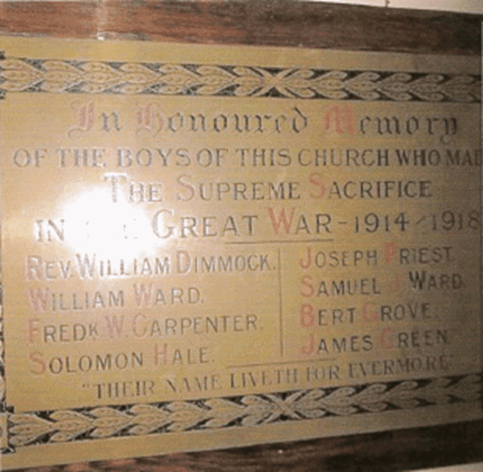
Netherton memorial plaque
THE FIRST WORLD WAR IN EAST AFRICA
In 1914 Africa was a patchwork of European colonies. In order to deprive the German Navy of bases the former German colonies were attacked by the allies. In West Africa the former colonies of Togoland and Kameroon were captured relatively easily in 1914-5. East Africa was a very different story. German East Africa was a large and stable colony, bordering on British East Africa (Kenya and Uganda) and Portuguese East Africa (Mozambique). The German military commander was Paul von Lettow-Vorbeck with an army of some 400 White and African officers and some 2500 African soldiers, known as Askaris. Despite superior numbers of British and Allied forces Lettow-Vorbeck held out and by the end of 1915 his army had swollen to around 14000.
In 1916 Jan Smuts, a former Boer soldier, was put in charge of around 90,000 White and African troops in order to try and defeat Lettow-Vorbeck. In October 1917 Lettow-Vorbeck and his army were forced to withdraw into Portuguese East Africa, but in Autumn 1918 re-entered German East Africa and then moved into Northern Rhodesia. He continued to elude the Allied forces until after the Armistice of November 11th. He did not surrender with his much depleted army of 1300 men until November 25th, the last German fighting force to do so.
The war in East Africa did not materially change the outcome of the Great War, but it tied up significant numbers of British and Colonial troops. Historians also suggest that the sight of the great European powers fighting each other began the process which would eventually lead to the independence of the African states. After the war German East Africa became the British Mandate of Tanganyika, which gained independence in 1961 and was united with Zanzibar in 1964 to form the present country of Tanzania.

1914 map of Africa
25TH (FRONTIERSMEN) BATTALION, ROYAL FUSILIERS
The 25th (Frontiersmen) Battalion of the Royal Fusiliers was formed in London on February 2nd 1915. It was one of a number of battalions of the Royal Fusiliers formed at that time, others being Public Schools (4 battalions), Sportsmen (2 battalions) and Bankers. It was formed from members of the Legion of Frontiersmen.
This had been set up in 1905 by a Roger Pocock to recruit ex-servicemen and others seeking adventure to be scouts for the British Army on the frontiers of the Empire. On the outbreak of war in 1914 some of them immediately volunteered to the War Office, were refused, but went to Belgium anyway and were involved in the first fighting at Mons.
The Frontiersmen battalion left Plymouth on April 10th 1915 and arrived at Mombasa on May 4th. They were involved in the fighting in East Africa, nicknamed “The Old and the Bold” until they returned to England in May 1917. The battalion was disbanded in June 1918.
The Legion of Frontiersmen still exists as a charitable organisation.
Why William Dimmock joined this particular group we do not know, but possibly the regular army would only have him as a chaplain, while it is clear that he felt he had to do more than this and wanted to be part of the fighting force or perhaps the somewhat romantic ideals of the Frontiersmen appealed to him.
THE BATTLE OF BUKOBA
In 1915 it was decided that some form of offensive action was needed and it was agreed to send a force across Lake Victoria to the German held town of Bokuba in order to remove its wireless installation and serviceable stores.
On June 6th the troops arrive at Kisumu on Lake Victoria, the terminus of the Uganda railway. The Frontiersmen contingent of 18 officers and 449 men went aboard the ship “Usoga” , leaving Kisumu on June 20th.
They were spotted by the Germans early on the 22nd and the plan was changed. They were landed north of Bokuba in a swampy area and would have to fight their way to the town. They were rowed ashore at about 6am and took up defensive positions. At about 8am they started to advance, meeting considerable opposition. By about 5 pm the Germans retreated into the town and the Fusiliers rested at a place which came to be known as “Fusiliers Knoll”.
On the morning of June 23rd around 6am they advanced towards Bukoba and despite a counter attack they entered the town about 12.30 and secured it by 1pm. It was during this attack that William Dimmock and five of his colleagues were killed, two others dying later of their wounds.
Some looting of the town took place later, used as a reason by the Army not to award any medals for bravery to those who took part.
Bukoba was abandoned and the frontiersmen returned to guard the Uganda railway.
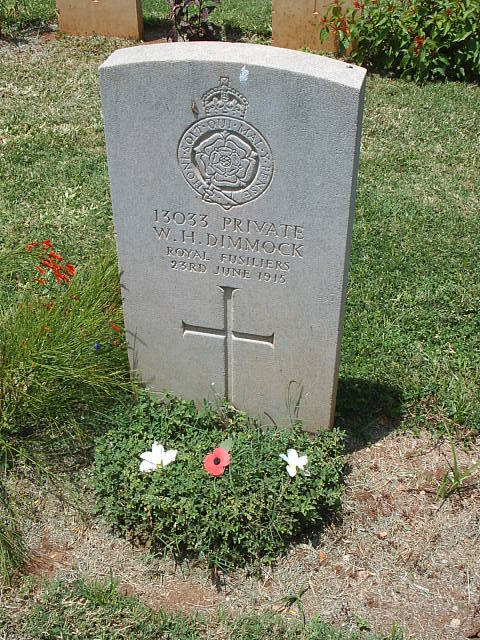
This photograph of Rev. Dimmock’s grave was taken by Maureen and Dave Leach during a trip to visit their daughter who was living in East Africa at the time.
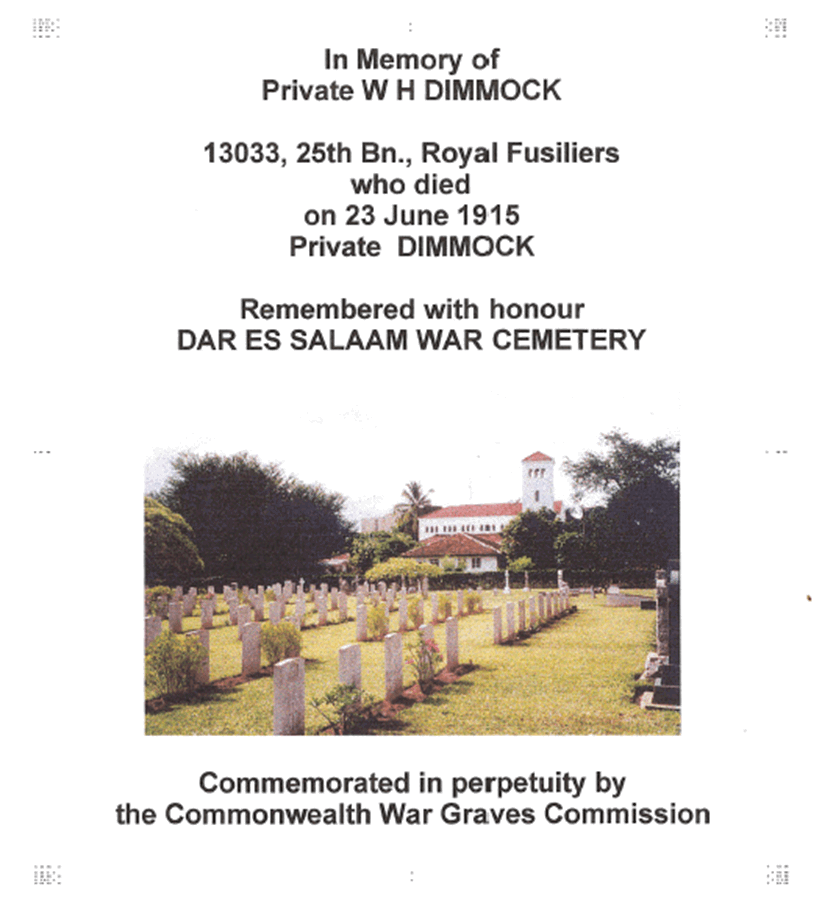
Sources: Wesleyan Conference Minutes 1913, 1914, 1915.
Newspaper cuttings reporting Wesleyan Conference 1915.
Information from Mr Keith Rothery, Chasetown.
Information from Mr Geoff Jones, Kingswinford
